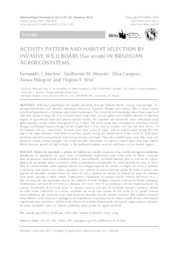Activity pattern and habitat selection by invasive wild boars (Sus scrofa) in brazilian agroecosystems.
Activity pattern and habitat selection by invasive wild boars (Sus scrofa) in brazilian agroecosystems.
Author(s): MARTINS, F. I.; MOURAO, G. de M.; CAMPOS, Z. M. da S.; PELLEGRIN, A. O.; SILVA, V. S.
Summary: Wild boar populations are rapidly spreading through midwest Brazil, causing crop damage, impacting biodiversity and, possibly, spreading diseases to livestock. Despite their threat, little is known about introduced populations in Brazilian agricultural landscapes. The critical lack of knowledge about basic aspects of wild boar spatial ecology led us to evaluate home range sizes, activity pattern and habitat selection in interface regions of agricultural crops and natural riparian forests. We captured and monitored seven individuals using global position system collars throughout 19 to 77 days. The home range sizes calculated by Minimum Convex Polygon and Biased Random Bridge Kernel ranged from 273 to 1253 ha (median = 497 ha) and from 129 to 779 ha (median = 235 ha), respectively. Animals were more active at night, with an activity peak during the first half of the night (between 19:00-03:00 h) and less activity during the hottest hours of day (12:00 h). Wild boars positively selected riverine forests both during the day and night. They also avoided open areas (like crops and pastures), mainly during daylight. Our study provides information to improve control plans, directing capture efforts towards periods of high activity in the preferred habitats used by wild boars in the studied region.
Publication year: 2019
Types of publication: Journal article
Unit: Embrapa Pantanal
Observation
Some of Embrapa's publications are published as ePub files. To read them, use or download one of the following free software options to your computer or mobile device. Android: Google Play Books; IOS: iBooks; Windows and Linux: Calibre.
Access other publications
Access the Agricultural Research Database (BDPA) to consult Embrapa's full library collection and records.
Visit Embrapa Bookstore to purchase books and other publications sold by Embrapa.

